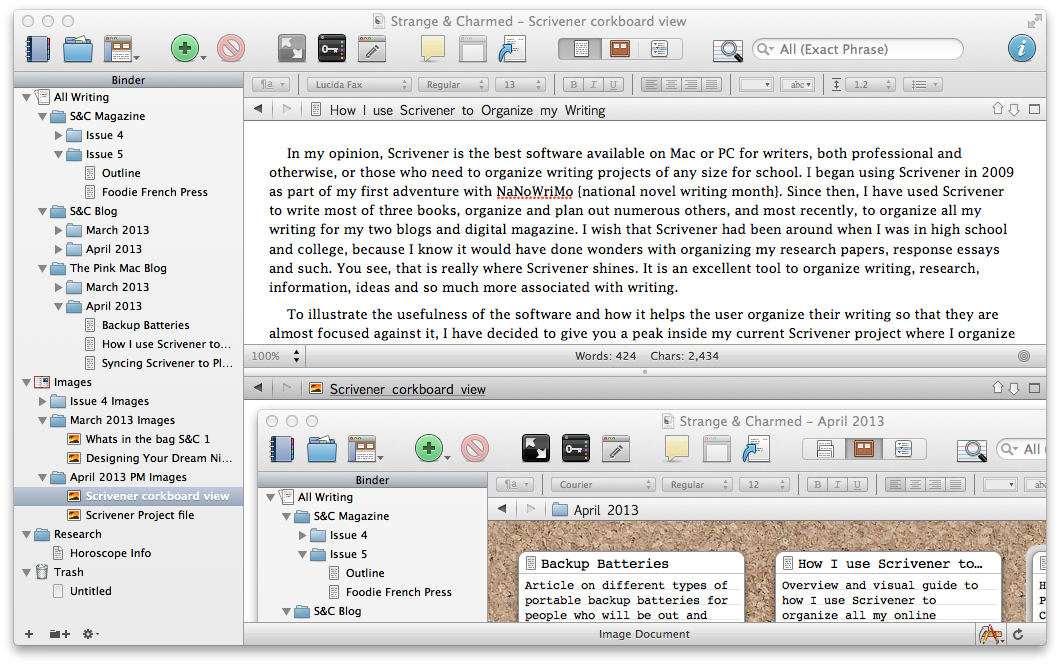

- #WRITING SCRIVENER WINDOWS FULL#
- #WRITING SCRIVENER WINDOWS SOFTWARE#
- #WRITING SCRIVENER WINDOWS DOWNLOAD#
As a discovery writer, I sometimes write scenes/chapters out of sequential order. Yes, I do love me some color coordination, thanks for noticing!īut what I love the most about the binder is the ability to move around the chapters and scenes. And you already saw how the colored labels also carry to the index cards. I didn’t assign colored labels to the notes, characters, places, etc, but you can do that as well. For the scenes, since this project is written in 3rd person POV between the two main characters (Simon and Isabel), I chose pink and blue just to differentiate whose POV it is at a glance (thanks, Lindzee A., for the tip!). For this project I chose a light orange for the front matter (title page, copyright, dedication, epigraph), a light yellow for the back matter (acknowledgements, note from the author, about the author), and a light green for the chapters. You can add/name your labels and choose the colors for those too. Then go to the General Meta-Data, on the right hand side, and click on labels.

They are called ‘labels’ in Scrivener.įirst, go to View at the top bar and scroll down to ‘Use Label Color In’, then put a tick mark on all options (binder, icons, index cards, outliner rows), or only the options you want, it’s up to you. You can use any colors you want for these tabs. Think of this as a real, physical 3-ring binder filled with colored page dividers and tabs.

You already had a quick view of the binder, which is the part on the left hand side of the Scrivener project. You can write the synopsis of each chapter on these cards, you can move them around, they can even have pictures instead of descriptions. If you’re a ‘plotter’ kind of writer and like to put down an outline, this can be especially useful. Look at all those colored index cards, just like a real corkboard. Like I mentioned, I don’t particularly use the corkboard, even though it looks so pretty. Who doesn’t love that?īefore I go on to my next favorite feature, I want to show you a view of the corkboard. I can add pictures to any of these to help with descriptions of places and characters. It’s very convenient, let me tell you.Īs you can see here, other than the chapters and scenes, I also have folders for general notes, ideas, characters, and places. I love this because I can take out parts of text that don’t work but they’ll still be attached to the scene where they came from, which means I can always put them back without the problem of trying to figure out where they go. The document notes area is where I write notes to myself and where I ‘store’ parts of the text I’ve cut. I don’t use the synopsis cards too much, but I’ll show how they can be used. I write by scenes, and each scene is assigned to a chapter. The main document area is where I do the writing. I will explain the binder area in more detail in a minute.
#WRITING SCRIVENER WINDOWS DOWNLOAD#
If you want to follow along, you can download Scrivener for free.Īs you can see, there are 4 main parts on my Scrivener board: 1. So here’s a compilation of my favorite features in Scrivener (Windows version), in no particular order. Keep in mind that it’s a very, very rough draft, and I’m only about 1/3 of the way into it. There isn’t a right way or a wrong way to use it, and other writers will use it in different ways.Īnother disclaimer- Scrivener was originally developed for Macs, and lots of features are still not available in Windows.Īnd another important disclaimer- I’m using screenshots of my Work In Progress. And no, I’m not being paid for this endorsement.ĭisclaimer- this is just the way I use Scrivener. I love it so much, I’m on a mission to convert writers everywhere to it. After watching a couple of tutorials on Youtube, and spending a few days playing around, I was sold.
#WRITING SCRIVENER WINDOWS FULL#
I had a coupon for Scrivener, and I tried it (though I must say that the full price is only $40, which is an absolute bargain). I knew Word was not working for me, and I needed something that could help me organize my writing and have it all available at one glance without the need to open a dozen Word documents, or have little sticky notes everywhere. I discovered Scrivener last year, after completing NaNoWriMo. While it gives you complete control of the formatting, its focus is on helping you get to the end of that awkward first draft. Scrivener is a powerful content-generation tool for writers that allows you to concentrate on composing and structuring long and difficult documents.
#WRITING SCRIVENER WINDOWS SOFTWARE#
What is Scrivener? It’s a software program for writers. Or I should say, Why I Love Scrivener So Much.


 0 kommentar(er)
0 kommentar(er)
